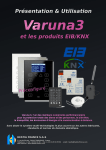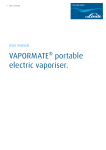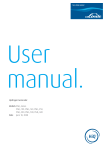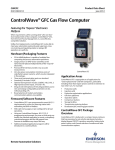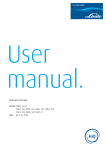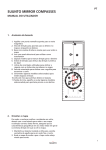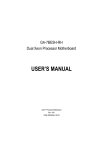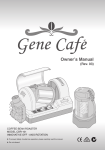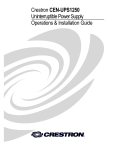Download 404775-Low Flow Zero Air Generator operating manual
Transcript
Operating Manual. ® HiQ Zero Air Station. Applicable to the following HiQ® Zero Air Stations: Zero Air Station 1.5, Zero Air Station 3, Zero Air Station 6, Zero Air Station 10, Zero Air Station 20 and Zero Air Station 30. Date January 2011 HiQ® Zero Air Station 02 HiQ® Zero Air Station Contents. 3 4 Introduction Chapter 1. Introduction. 41 5.1 Regular HiQ® Zero Air Station maintenance 5.2 List of consumables and accessories 5.3 List of spare parts and modules 5.4 Return the generator to the retailer or the factory General Informations and Compatibility to Normalisations 2.1 Notes on the FCC compatibility 2.2 CE Conformity 2.3 W.E.E.E. product recycling declaration 2.4 Security instructions and correct use Maintenance 45 Alarms and Troubleshooting 6.1 Troubleshooting 6 3 3 3 3 3 3 HiQ® Zero Air Station 1.5 HiQ® Zero Air Station 3 HiQ® Zero Air Station 6 HiQ® Zero Air Station 10 HiQ® Zero Air Station 20 HiQ® Zero Air Station 30 Specifications and Description 47 3.1 Specifications 3.2 Instrument presentation 3.3 Functioning principle: basic equipment 3.4 Functionng principle: options 3.5 Internal structures 12 This manual provides the necessary information for the installation and operation for the HiQ® Zero Air Station series. It also includes information for simple maintenance operations as well as troubleshooting tips. This manual is applicable for the following Zero Air station models: Installation and Operation 4.1 Upon receiving your HiQ® Zero Air station 4.2 Delivery content 4.3 Station installation 4.4 Electric connections 4.5 Fluidic connections 4.6 Initial Start-up 4.7 Control Software description Notes This operating manual consider and describe an instrument generally equipped with the most complex configuration; should the explanation concerning the most complex instrument be to different from the simpler instrument, both cases will be described separately. 03 04 HiQ® Zero Air Station HiQ® Zero Air Station Chapter 2. General Information and Compatibility To Normalisations. 2.1 Notes on the FCC compatibility 2.2 CE Conformity 2.4 Security Instructions and correct use This equipment has been tested and found compatible within the Class B limits of the digital instruments, chapter 15 of the FCC regulation. These limits have been defined in order to provide a reasonable protection against the strong electrical interferences in the installations inside a residential area. This instrument generate, use and can send out some radio frequency if it’s installed without following the manufacturer instructions; moreover it can generate in the case of certain installations some interferences to the electrical radio communication. This equipment was built in compliance and is compatible with EC recommendations concerning electrical safety and electromagnetic emissions. It complies with 89/336/EWG, 93/98/EWG, standards EN 50 081-1, in 50 081-2, EN 50 082 - 1 and EN 50 082 - 2. This Zero Air station has been designed in order to produce zero air for laboratory applications. This generator must only be used for such applications respecting the specifications and recommendations for its proper use described in this operating manual. The main recommendations are: Should this instrument produce some significant interference to the radio and television, this case can be identified by plugging and unplugging the instrument. We recommend, in order to eliminate the interferences, to take one or more of the following actions: Note Any modifications on the instrument which have not been approved in writing by the manufacturer will automatically cancel the manufacturer warranty. If such modifications are nevertheless undertaken, they are under the user responsibility; the manufacturer will under no circumstances be responsible for any damages direct or indirect which they would cause 2.3 W.E.E.E. product Recycling declaration 3 Re-orientate or redirect the antenna 3 Increase the distance between the equipment and the receiver 3 Plug the equipment in a different electric circuit from the one alimenting the receiver 3 If none of the above mentioned actions are giving results, contact an experienced technician or selling agent in radio/TV. In agreement with the European EC/2002/96 directive on electrical and electronic equipment recycling, this product may not be disposed of in the garbage. For recycling information, contact the company who sold this product. If you want to get rid of this instrument, identify it as such and direct it to a certified recycling centre. This generator should only be operated and used indoors. This generator can only be used at temperatures above 4°C This generator should only be used in a well ventilated room. In case of inside maintenance requirements, always unplug it before opening the casing(s). 3 Only the spare parts described in chapter 5 can be changed by the user. Other maintenances action on this instrument must be undertaken by trained and authorized technician. 3 3 3 3 05 06 HiQ® Zero Air Station HiQ® Zero Air Station Chapter 3. Specifications and Description. 3.1 Specifications Zero Air outlet flow (values at 20°C and 1013 mbar of atmospheric pressure) Delivery pressure Zero Air purity Operating principle for removal of hydrocarbons Drying system Display Keyboard Manual interface control Remote control Alimentation voltage HiQ Zero Air Station - 1.5 : Flow rate 1.5 NL/min maximum HiQ Zero Air Station - 3 : Flow rate 3 NL/min maximum HiQ Zero Air Station - 6 : Flow rate 6 NL/min maximum HiQ Zero Air Station - 10 : Flow rate 10 NL/min maximum HiQ Zero Air Station - 20 : Flow rate 20 NL/min maximum HiQ Zero Air Station - 30 : Flow rate 30 NL/min maximum Up to 6 barg (90 Psig) <0.1 ppm Total Hydrocarbons catalyst chamber filled with Pt+Pd catalyst heated to very high temperature Static Dryer without maintenance Monochrome LCD graphic display, of 128 x 64 pixels Contextual, touch sensitive Adjust operating points, system status Functioning diagnosis, users settings, keyboard and screen adjustment. Through USB interface: alarms standard reading Remote control software on option Through dry rely ; 1 entry (Start/Stop) and 1 alarm 100 V/60Hz; 110-117V/50-60Hz; 220- 240V / 50-60 Hz Maximum electric consumption Pressure display accuracy Outlet fitting Functioning conditions: 3 Temperature 3 Relative Humidity Transport and storage conditions: 3 Temperature 3 Relative Humidity Category of surge Grade of pollution Sound pressure Net weight Casing size : all models Packaging size HiQ Zero Air Station - 1.5 : 300W maximum HiQ Zero Air Station - 3 : 300W maximum HiQ Zero Air Station - 6 : 300W maximum HiQ Zero Air Station - 10 : 550W maximum HiQ Zero Air Station - 20 : 550W maximum HiQ Zero Air Station - 30 : 550W maximum 0.1 bar (± 0.5 %) Stainless steel double ring : 1/8” for ZAS 1.5 to 10 1/4” for ZAS 20 and ZAS 30 +10ºC to +35ºC 0-80%, non condensing +0ºC to +35ºC 0-90%, non condensing II 2 <55 dB(A) ZAS-1.5L : 40 Kg ZAS-3L : 45 Kg ZAS-6L : 45 Kg ZAS-10L : 55 Kg ZAS-20L : 55 Kg ZAS-30L : 60 Kg 360 x 640 x 695 mm (LxPxH) 450 x 800 x 800 mm (LxPxH) 07 08 HiQ® Zero Air Station HiQ® Zero Air Station 09 1 2 3 4 5 Zero Air Station 1 5 Frame, 2 Electronic control module, Air compression module 3 Tank, 4 Air purifier module, 3.2 Instrument presentation 3.3 Functioning principle: basic equipment 3.4 Functioning principle: options 3.5 Internal Structures HiQ Zero Air Stations are supplied as single case unit. The unit should be placed on the floor under the working bench. The front face is divided into two parts, the upper part contains an information screen with touch keyboard and the lower part fitted with hinges allow to access to the pressure setting and inlet filter. The HiQ® Zero Air station models utilise a multi-stage process to purify ambient air into analytical grade air. Compressed ambient air is initially passed through highly efficient pre-filtration to remove both moisture and particles greater than 5 microns. After filtration, the air is channelled into a stainless steel catalyst chamber to remove background hydrocarbons and carbon monoxide. The chamber is filled with a highly efficient platinum + palladium catalyst which has been heated to very high temperature to ensure final hydrocarbon removal to less than 0.1 ppm. The zero air is stored in an internal storage tank allowing the compressor to stop when reached the upper pressure level and starting again when at the lower level. An additional final high-grade filter is used to remove 99.99% of particles greater than 0.5 microns. At this point the Air is available at the outlet fitting. The compressor is driven by the tank pressure ; it will stop itself when the upper set pressure value is reached and start again when the lower set pressure is reached which will be above the set outlet pressure. 3.4.1 Remote control by dry rely The option remote control by dry rely can perform a simple remote control between the zero air station and a external compatible « controller ». This remote control enable the start up and shut down of the Station through a supply voltage between 2 terminal of the connector. The station responds by closing or opening a relay in the event of an alarm. The remote control can be NC (normally closed) or NO (normally open). The Zero Air station, is built on a modular concept, it is mainly composed of control module and a service module: 3 a light grey steel case , composed of a frame with sheet –metal protection panels. 3 an electronic control module 3 an air compression module 3 a purification module 3 tanks and linking tubes with the filtration module The lower part of the back plate is the air compression module and the upper module is the compressed air purification module. The main plug connection, fuse and power switch as well as the Zero Air outlet is located on the upper module. 3.4.2 Remote control via USB interface USB remote control option allows you to read and monitor the operation of the instrument from a PC. The delivery of the option is a software owner running under Windows (Windows 2000, XP, VISTA and Windows 7), a USB cable and operating manual. The details of this option are described under 4.10. 10 HiQ® Zero Air Station HiQ® Zero Air Station 11 6 5 7 4 2 1 4 4 3 5 1 3 2 2 MB3800 card fixed inside the lead (view from inside) 1 5 3.5.1 Electronic module The electronic control module is composed of a plastic fire proof cover, upper part of front face and one board, MB3800. The main board MB3800 has the following functions: 3 Support and management of the LCD screen with its integrated touch keyboard 3 External communications 3 Communications to other modules 3 Main processor Note: the MB3800 is powered from the purification module. Inlet filter, 2 Ventilation system, Cooling coil 3 Compressor, 4 Command connector, 3.5.2 Air Compression module This module has: 3 One Inlet filter(s), can be reached from the back of the lower front face 3 The compressor, the type vary depending on the zero air station capacity, 3 A stainless steel cooling coil 3 the ventilation system 1 6 Static dryer, 2 Evaporator, 3 Catalytic oven with cooling coil, Coalescing filter (purge V4), 7 Air Outlet module 4 Connection fittings with tank(s), 3.5.3 Air purification module This module has: 3 The coalescing filter with automatic purge 3 The static dryer 3 The catalytic oven with cooling coil and forced ventilation. Evaporator fixed on top 3 The outflow module 3 The electronic control board GOUS3L0 3 The power supply board PS3550 3 The pressure regulator with 2 sensors fitted on a board 5 Gous3-ZAS with power supply PS3550-30, 12 HiQ® Zero Air Station HiQ® Zero Air Station 13 Chapter 4. Installation and Operation. 4.1 Upon receiving your HiQ® Zero Air station 4.2 Delivery content Each instrument is inspected and packaged prior to transport with great attention. Immediately after receipt, we recommend to perform a quick visual inspection of the package as well as the LABEL-SHOCK shock detector. If it turned red, report it in writing to the carrier at the time of delivery Quantity 1 1 1 1 1 1 The Zero Air station is put on an individual wooden mini-palette 40x80cm, which is the basis of its transport packaging. Its upper part is protected by shaped foams and a thick cardboard. The thick cardboard is screwed on the palette. The unpacking of the station from its packaging start by unscrewing the cardboard, then cutting the straps. At this stage it is possible to verify the visual integrity of the instrument. Any damages must be immediately identified and photographed; It should be reported to the carrier as well as to your Linde representative. DO NOT ATTEMPT TO USE THE GENERATOR. For major damages, the generator shall be returned to the manufacturer after coordination with Linde customer service who will provide return goods documents and procedures. 4.4 Electric connections Description HiQ® Zero Air Station (ZAS) Quick starting guide (QSG) Operating manual on CD Verification and calibration certificate Electric cable 230V, CE Shipping box Mains: Connect the Zero Air station with the electrical cable provided; if using an alternative cable, verify that it has the appropriate ground wire ( 3X1mm2 minimum). Make sure laboratory differential circuit breaker can absorb an increased current of at least 6A without switching off. Note: the Zero Air station is equipped with fuses to protect the compressor on one hand, the Catalysis oven and electronics control on the other hand. They are placed on the back of each tray. 4.3 Station installation 4.5 Fluidic connections 3 The Zero Air station must be installed on a flat surface, without vibrations, avoiding potential shocks and excessive heat source. The generator should not be in contact with other devices on any of its walls, a sufficient distance is necessary to avoid to communicate to other instrument the small vibrations produced. 3 Operate the generator in an open and well ventilated area, in which the temperature does not go below 0°C. The good functioning of the generator is guaranteed for a temperature between +10 and +35°C. 3 To ensure proper ventilation, a clear space of at least 20cm is necessary at the back of the generator. The Air cooling admission is located on the lower front panel and should under no circumstances be obstructed. The produced zero air is available from the ZERO AIR OUTLET located at the back of the instrument. This outlet is equipped with a stainless steel compression fitting. We recommend that the supply line from the station to point of use be a laboratory grade stainless steel (1/8” for the 1.5 – 6L units and 1/4” for the 10-30L units) which has been cleaned and free from grease and other particles. Use of PFA or TEFLON tubing is not recommended as hydrocarbon can diffusion through the walls and change the quality of the zero air. Perform the connection to your application only after the purge cycle described below have been performed. The outlet pressure is adjusted by the pressure regulator placed under the lower panel and can be visualized permanently on the screen. CAUTION: Your Zero Air station has been tested and purged prior to shipment to remove any hydrocarbons originate from ambient air. After a downtime of several days or weeks, the generator should be purged again prior to use according to the purge cycle, described below. 14 HiQ® Zero Air Station HiQ® Zero Air Station 4.6 Initial Start-up CAUTION: the dialogue between the generator and its user is initially done via the touch screen placed on the front top Panel. Orders or submenus are obtained by pressing lightly with a finger on the chosen area. We strongly discourage the use of objects such as pen pointing, the sensitive side of the screen might be irretrievably degraded. 4.6.1 Start-up Turn the generator on with the switch placed on the back of the generator. The identification image appears during approximately 30 seconds the following information will be shown, the maker, model, serial number as well as the software revision. ZERO AIR STATION ZAS-3 EU Software Rev V1.1 Serial # ZAS1-091004099 After the presentation, the main image appears II STARTING Menu 1. Passive Purge Leave the generator continuously working between 1 or 2 hours, limiting the outflow to 1 Nl/min. Limiting the outflow with a restrictor or needle valve mounted on the zero air output. Oven Temperature : 245ºC and the oven starts heating. When the oven temperature reaches approximately 550 ° C, the compressor starts and fill in the tank. RUNNING Menu Main Menu Tools (Device must be on STANDBY State) ESC 7/7 Purge Cycle Under Process Remaining Time : 118min ESC 3/3 3 Select the function PURGE, then press on. 3 Press on the function MENU then select the function TOOLS, then press It is possible to check the filling up progression of tank by pressing on MENU then select Diagnostic and AIR Pressure. The image present the tank pressure, the outlet pressure, the maximum pressure (alarm), and the functioning state of the compressor. ESC 2. Active Purge Proceed to the purge cycle proposed by the generator software, for this: Pressure Set : 5.0 bar Actual value : 0.2 bar Oven Temperature : 648ºC Note: In order to facilitate the first start-up in your laboratory, the Zero Air station has been set in the factory for an automatic start-up and produce zero air pressure at 5 bar. Purge Cycle Pressure Set : 5.0 bar Actual value : 0.2 bar II Tools 4.6.2 Purge Cycle Before connecting the generator and the alimentation tube to the consumer, it is necessary to proceed to a purge of the system, for this, two solutions are proposed: STOP At this point the Zero Air station starts a tank filling up phase followed by its emptying phase up to 1 bar. The full purge cycle time depend on the compressor capacity, and of the volume to be purged and the maximum consummation, therefore of the model of the station The purge cycle can at any time be stop by pressing on STOP When the cycle is finished, it goes back into the normal functioning windows. From this moment, it is recommended to connect the outlet tube to the consumer and proceed to the pressure setting. 15 16 HiQ® Zero Air Station 4.6.3 Outlet pressure setting The outlet pressure is regulates by a manual regulator, its setting is made manually while reading on the screen the pressure value: 3 Open the front lower panel, 3 Pull the security button to set it free from its security setting 3 Adjust the indicated pressure value requested for the installation: turn clockwise to increase the value. 3 Push back the button into its security setting. Note: The setting procedure of the outlet pressure automatically execute a rough setting (+/- 0.5bar) of the alarms pressure setting. A different or finer setting can be done through the function AIR PRESSURE ADJUSTMENT. At this stage, the generator is working with its factory settings. In order to improve your skills on performance, software, maintenance period, alarms and trouble shooting, we recommend that you read the further chapters and paragraphs of this document. HiQ® Zero Air Station 4.7 Control software description 4.7.1 Features overview Once the initial boot is made, the next screen appears: I> Standby Menu Pressure Set : 5.0 bar Actual value : 0.2 bar In General, for navigation, the following symbols are used: and To navigate from one menu to another or from one page to another To enter the relevant menu ESC To exit the current MENU and return to the previous menu 1/6 the current page number and the number of pages of the relevant menu Auxiliary functions: Allows managing the screen and clock as well as setting the working units. Main Menu Auxiliary Functions By pressing the arrow we reach the menu « Diagnostics », which allows to observe all important functioning settings of the station. Main Menu This is the main menu allowing to set the instrument in mode: Generation (running) or stand-by. ESC 4/6 Special functions: Which allow to set the restart mode in case of power cut as well as the remote control and the mode alarms. Diagnostics Before generating some zero air, it is useful to adjust some settings of the generator. By pressing « MENU » it is possible to access to the following menus : Main Menu ESC 2/6 Special Functions Main Menu Other menus are: Air Pressure Setting Tools: Providing access to various tests including the compressor test. Main Menu ESC 1/6 17 Tools The First menu « AIR pressure setting » (setting of the AIR output pressure) allows as its name indicate to adjust the Air output pressure. ESC 3/6 ESC 5/6 18 HiQ® Zero Air Station HiQ® Zero Air Station Then the following window appears: Alarms and events: Allows to view the past events. II Running Pressure Set : 5.0 bar Actual value : 0.2 bar Oven Temperature : 50ºC Alarm 1 Alarm 2 ... ... ... ESC Alarm + Events ESC Standby Shortcut: The center of the screen below is an active area to directly reach the pressure adjustment window. Pressure Set : 4.0 bar Actual value : 0.2 bar 4.7.2 Menu « Air pressure setting » The tree menu « Air pressure setting » is as follow: 6/6 Start up of the Zero Air generation: I> Alarm Menu Main Menu By pressing on « Alarm » the window with the list of alarms appears: Menu Pressure Set : 5.0 bar Actual value : 0.2 bar To stop the generation press « II » the instrument goes automatically on « Stand by ». In case of alarm, the message « ALARM » appears alternating with the message “Running“ or “standby“. II Running 3 3 3 3 Once the pressure has been selected (see next chapter), just press on « I> » to start the Zero Air generation. Air Pressure Setting ESC Menu Pressure Set : 5.0 bar Actual value : 0.5 bar The state of the generator: Stand-by, Running, alarm The set pressure The actual pressure The HC catalysis oven temperature I> Oven Temperature : 20ºC Main Menu In general the main page indicate: Standby 1/6 Menu Air Pressure Setting Pressure Set : 5.0 bar Actual value : 1.5 bar 4.8 bar Oven Temperature : 80ºC IIIIIIIIIIIIIIIIIII Touch to memorize Oven Temperature : 390ºC II Alarm Pressure Set : 5.0 bar Actual value : 0.8 bar Oven Temperature : 120ºC Menu In addition, the main page allows you to: 3 To start or stop the zero air generation 3 To have access to the sub menu 3 To see the alarms. ESC 1/1 19 20 HiQ® Zero Air Station HiQ® Zero Air Station Air Pressure Setting Maximum value : 6 bar Actual value : 3.5 bar New Value : 4.8 bar Diagnostics Diagnostics Air Pressure Case Temperature 4.7.3.1 Sub-menu « Air pressure » This pressure is the outlet generator pressure, which will be applied onto the unit. Diagnostics ESC ESC ESC 1/5 4/5 21 Air Pressure Air Pressure Setting Diagnostics Diagnostics ESC 1/5 Value recorded Oven Temperature Device Features Air Pressure ESC 2/5 Diagnostics Functioning Time Main Menu ESC Diagnostics ESC 2/6 3/5 5/5 This menu allows only to observe the various functioning parameters of the instrument. In order to set the outlet pressure, proceed as follow: 4.7.3 Menu « Diagnostics » The simplified tree menu « Diagnostic » is as follow: ESC Moving within the tree is done by using the arrows « » and « ». Once the requested setting is found, press on « » to enter into the sub-menu and « ESC » to come out. Act Value : 4.5 bar Tank Value : 6.2 bar Max : 6.0 bar Min : 0.5 bar IIIIIIIIIIIIIIIIIIIIIII 75% ADC : 3125 mV Tank : 3824mV ESC « Set Value » represent the requested pressure value. « Act Value » represent the outlet pressure measured by the sensor. « Tank Value » represent the pressure value inside the tank. « Max » and « Min » are the maximum and minimum pressure values. The sign « IIIIIIIIIIIIIIIIIII 98% » indicate at which % max of the pressure the setting is. « ADC » indicate the value of the pressure analogous digital converter. 22 HiQ® Zero Air Station HiQ® Zero Air Station 4.7.3.2 Sub-menu « Oven Temperature » This value indicates the catalysis oven temperature Diagnostics Functioning Time Total Functioning Time Actual Value : 12 Hours Next Maint. : 4000 Hours Remaining Time : 3988 hours IIIIIIIIIIIIIIIIIIIIIII 99% Case Temperature Actual Value : 8 Hours Next Maintenance : 4000 Hours Remaining Time : 3992 Hours IIIIIIIIIIIIIIIIIIIIIII 98% Maintenance Done ESC Oven Temperature ESC 23 Case Temp. : 26°C (79°F) Alarm : 57°C (135°F) ADC : 432 Voltage : 263 mV ESC ESC 2/5 Oven Temperature Actual Value : 645ºC Max Value : 660ºC ADC : 2825 mV « Actual Value » functioning time since beginning of the generator life « Next Maint. » is the functioning time corresponding to the next maintenance. « Remaining Time » remaining time before the next maintenance. The sign « IIIIIIIIIIIIIIIIIII 99% » indicates the functioning « reserve » before maintenance Once the « remaining time » reaches zero, an indication « Alarm » appears on the screen main menu: At this time « maintenance done » disappear, the messages « Next maintenance » is incremented by 4000H and the message « Remaining time » is up dated. Moreover, the message « Alarm » on the main menu disappear. « Case Temp. » represents the temperature of the electronic module « Alarm » is the Alarm value « ADC » represents the value of the analogue to digital voltage converter 4.7.3.4 Sub-menu « Case Temperature » This value tells about electronic case temperature. 4.7.3.5 Sub-menu « Device Features » This sub menu allows to view the generator model, the serial number as well as the version of the software. Diagnostics I> ESC Alarm Diagnostics Menu 4.7.3.3 Sub-menu « Functioning Time » This value indicate the functioning time of the generator as well as the next maintenance. Pressure Set : 5.0 bar Actual value : 4.9 bar Diagnostics ESC 3/5 Device Features Oven Temperature : 645ºC Functioning Time Case Temperature ESC 4/5 ESC When the maintenance is done, go back to the menu « Diagnostic » \ « Total functioning time » and press on « Maintenance done » 5/5 24 HiQ® Zero Air Station HiQ® Zero Air Station Device Features Tools Mod : UZAS 3L-EU S/N : UZAS1-100304567 Software Revision : V1.2 In order to use these tools, it is absolutely necessary to place the instrument in “Stand-By“ State mode, as below. By pressing on « » It is possible to go into the menu and adjust the setting value. I> Oven Test Standby Valve Test Menu ESC ESC 2/4 Pressure Set : 5.0 bar Actual value : 0.2 bar Touch to open valve Oven Temperature : 245ºC Tools 4.7.4 Menu « Tools » The tree of this menu is the following: ESC Main Menu Purge Test 4.7.4.1 Sub-Menu « Valve Test » This test allows to open or close the zero air outlet valves. Valve Test Tools Tools ESC 3/4 Touch to close valve Valve Test ESC 3/6 Tools ESC Tools ESC 1/4 Pump Test Valve Test Valve Test ESC 4/4 Are you sure to enter? ESC 1/4 ESC 25 HiQ® Zero Air Station 26 HiQ® Zero Air Station 4.7.4.2 Sub-Menu « Oven Test » This test allow direct access to the catalysis oven setting which can be modified as requested. WARNING: in order to allow for a very different setting to factory default setting, this feature is little protected against excessive adjustment values. A constant temperature setting above 750ºC temperature can damage the instrument. Tools Oven Test Oven Test Purge Test Are you sure to enter? Are you sure to enter? 27 4.7.4.4 Sub-Menu « Pump Test » This test allows to start or stop the internal compressor Tools ESC Pump Test ESC By pressing keys ++ and – as well as keys + and –, the temperature setting of the catalysis oven is modified. It should be noted that the measure is done inside the heating body and not on the outskirt of the oven; this explain the quick reaction of the temperature value. By pressing on key « » It is possible to enter into the menu and opening or closing the purge. ESC 4/4 Purge Test Pump Test Touch to open purge Are you sure to enter? ESC 2/4 4.7.4.3 Sub-Menu « Purge Test » This test allows opening and closing the purge valve of the coalescent filter. Oven Test ++ Tools ESC + Purge Test Purge Test Regulate oven to 700ºC -- ESC By pressing on key « » It is possible to enter into the menu and control the start of the compressor as well as checking the Air pressure variation inside the tank. Act temp. 285ºC ESC ESC 3/4 Pump Test Touch to close purge ESC Tank pressure value : 3.5 bar Touch to Stop Pump IIIIIIIIIIIIIIIIIIIIIII 72% ESC 28 HiQ® Zero Air Station HiQ® Zero Air Station Auxiliary Functions 4.7.5 Menu « Auxilary functions » This menu tree is the following: Auxiliary Functions Clock Settings Main Menu Unit Change + Sounds Menu 12 - Auxiliary Functions ESC 3/6 ESC 6/6 ESC Month ESC 5/6 Auxiliary Functions Auxiliary Functions Clock Settings 4.7.5.1 Sub-Menu « Clock setting » This sub menu is used to set the time and date of the instrument ++ Auxiliary Functions Alarm setting + 17 -- - Clock Settings ESC 4/6 Clock Settings ESC Day ESC 1/6 Auxiliary Functions Auxiliary Functions Touch Pad Calibration ESC Clock Settings 1/6 ++ Clock Settings + 10 - Display Settings ESC ESC 2/6 ++ 5/6 2009 -ESC - + ESC Year Hour 29 HiQ® Zero Air Station 30 HiQ® Zero Air Station Clock Settings ++ Auxiliary Functions + Units This sub menu allows to set the contrast (Contrast) as well as the reverse light screen (light back). Proceed adjustments with buttons « + », « ++ » and « - » and « -- » 4.7.5.2 Sub-Menu « Display Setting » 27 -- Temperature Display Settings ESC Min The value entered is validated be pressing on « ». The software automatically advances to the next value. ESC 2/6 ESC 2/2 4.7.5.3 Sub-Menu « Unit Change » This menu allows choosing the working units Clock Settings Pressure Auxiliary Functions Display Settings 17/12/2009 10:27 ++ + ESC ESC ESC Once entered in the menu « Clock setting », the software requires in turn the year (Year), the month (Month),the day (Day), the time (hour) and the minute (Min). Once in the menu, the « + » and the « ++ » allows to increase the value, the « - » and the « -- » allows to decrease the value. The « ++ » and « -- » allow a rapid scroll of the values, the « + » and « - » allows a slow scroll of values. Once all the values are entered the last “page“ displays the date and time set. 3/6 1/3 Contrast Pressure Units Display Settings Kpa ++ + Pressure IIIIIIIIIIIIIIIIIIIIIII -- The entered value is validated by pressing « ». The software automatically advances to the next value. Unit Change IIIIIIIIIIIIIIIIIIIIIII -- Bar ESC ESC ESC Backlight 1/2 2/3 31 32 HiQ® Zero Air Station HiQ® Zero Air Station Pressure Once in the « UNIT » menu it is possible with the keys « » and « » to change the following units: Pressure and Temperature. Calibration Touch black square Psi ESC 3/3 Once in the requested window (Pressure or Temperature) press on « » and choose with the arrows « » and « » then validate with « » the requested unit. Temperature 4.7.5.4 Sub-Menu « Alarm Setting » 0 This sub menu allows enabling or disabling the sound signal in case of alarm (Buzzer). Once in the menu, choose between “ON” or “OFF” with the arrows then valid with « ». Calibration Touch black square Auxiliary Functions ºC 1/2 X:0 Y:0 For the pressure, the units are : Bar, Kilo Pascal and PSI For the temperature the units are : Degree Celcius and Fahrenheit ESC Value recorded 4.7.5.5 Sub- Menu « Touch pad Calibration » This sub menu allows to calibrate the touch screen. Alarm functions Temperature Remove finger ESC 4/6 Auxiliary Functions Touch Pad Calibration Touch black square Auxiliary Functions ºF ESC 5/6 X:0 Y:0 ESC 2/2 Calibration Buzzer ON ESC Touch the pad 0 33 34 HiQ® Zero Air Station HiQ® Zero Air Station Special Functions 4.7.5.6 Sub-Menu « Sounds Menu» Auxiliary Functions Touch black square Special Functions Power Up Control Remove finger Pressure Level Alarm Sounds Menu Calibration Once in the sub menu « touch pad setting » the software ask to press on the screen (Touch the pad). After having press on the screen, the software ask to press on the square place on the top left hand corner and to keep the finger on it (touch black square). At that time a counter starts up. Once arrived at the value 10, the next page ask to remove the finger (remove finger) appears. Then another calibration point is requested (bottom right hand corner). When done, the message « calibration done » (Pad Calibration done) appears. ESC 6/6 1/6 ESC Sounds Menu Service Alarm Settings ESC 2/6 ESC 5/6 Special Functions Special Functions Log Book download Pass Word This sub menu lets you adjust the duration of the sound emitted when the screen is touched. A setting to 0% totally removes the sound. 4.7.6 Menu « Special functions » This menu tree is the following: ESC Main Menu Special Functions ESC 5/6 Special Functions Remote Control IIIIIIIIIIIIIIIIIIIIIII 50% 4/6 Special Functions ESC Pad Calibration done ESC 3/6 ESC 6/6 35 36 HiQ® Zero Air Station HiQ® Zero Air Station Power Up Control 4.7.6.1 Sub-Menu « Power Up Control » This menu is used to determine, in the event of power failure, in which state the instrument must restart. There are two possibilities: 4.7.6.3 Sub- Menu « Log Book Download » This menu allows you to download the log book on a PC in order to send it to the after sale service for a help in the diagnosis. Then, on the PC menu \Start up \all programs \accessories \communication \Hyper Terminal open the Hyper Terminal program On Last Running Status Restart in the same Status it was before the power failure (On Last Running Status). Restart and go in « Stand-By » Status (On Standby Status). Special Functions ESC 2/2 Log Book Download Special Functions 4.7.6.2 Sub- Menu « Remote Control » ESC 3/6 Special Functions Power Up Control Log Book Download ESC 1/6 Remote Control Please Connect to a PC Power Up Control ESC 2/6 ESC On Standby Status ESC 1/2 37 Once the page « log Book Download » is reached, it is necessary to connect the generator to a PC through a USB link. If it’s the first time the generator is connected to a PC, he will request to proceed to the set up of the « driver ». It is stored on the CD provided with the instrument in the directory « driver » Enter a name and validate with « ENTER » 38 HiQ® Zero Air Station HiQ® Zero Air Station Log Book Download 4.7.6.4 Sub- Menu « Pressure Level Alarm» This submenu allows to adjust the value corresponding to the minimum pressure alarm. 4.7.6.5 Sub-Menu « Service Alarm Settings » Special Functions Please Connect to a PC Special Functions Service Alarm Settings ESC Pressure Level Alarm The following window appears ESC 4/6 ESC 5/6 PassWord By pressing on « », the setting window appears Choose « port COM » on which is plugged the USB link OK Pressure Level Alarm 000000 ++ Log book appears (coded) in Hyper Terminal Make adjustments as on the above image. Then validate with « ENTER ». Then validate on the instrument by pressing on « ». + ESC -- IIIIIIIIIIIIIIIIIIIIIII 4.2 bar - ESC Pressure Min 39 40 HiQ® Zero Air Station HiQ® Zero Air Station 41 Chapter 5. Maintenance. 1 1 1 2 1 4.7.6.6 Sub-Menu « Pass Word » 4.7.7 Menu « Alarm » This menu allows to check the list of the latest alarmes: Special Functions Pressure regulator's adjustment button, 2 Inlet filter Pass Word Alarm ESC 6/6 ESC 6/6 PassWord Alarm 000000 ESC This sub menu allow access to the function « USINE » is not accessible to persons who have not received adequate training. 15.12 10 :56 Reset 10.12 13 :34 Reset 28.11 07 :03 Pressure failed … … ESC Screws to fix the module (4x) by drawer 5.1 Regular HiQ® Zero Air Station maintenance The following table summarizes the acts of maintenance as well as consumables probable replacement frequency. Special Functions 1 Maintenance Air inlet filter Coalescing filter with silencer Catalysis oven with heating cartridge Frequence Every 6 months (4000H) Every year (8000H) Every 3 years (24000H) 5.1.1 Air inlet filter 3 Open the lower part of front face, in order to access to the inlet filter. 3 Unscrew the filter and replace it by a new one 5.1.2 Coalescing filter with silencer To replace the coalescing filter and silencer, we recommend to remove the Air purifier module: 3 Unscrew the lateral protection plates on both sides 3 Disconnect the cable and tubes on the rear face 3 Unscrew the 4 screws which fix the drawer 3 Remove the drawer and place it on a table 3 Remove the oven ventilation streamline body 3 Unscrew the silencer and replace by a new one 3 Open the coalescing filter and replace the filtering media, 3 Reassemble and verify tightness 42 HiQ® Zero Air Station HiQ® Zero Air Station 43 3 2 1 Silencer, evaporator, 2 Catalysis oven, 3 1 Coalescing filter 5.1.3 Catalysis oven 3 Remove the drawer and place it on a table 3 Remove the oven ventilation streamline body 3 Disconnect the tubes 3 Disconnect the heating cartridge cable from the electronic board (Phoenix 5 pins) 3 Unscrew, from under the drawer, the 4 screws which fix the oven. 3 Exchange with the new one and replug. 5.2 List of Consumables and accessories 5.3 List of main spare parts and modules The following table lists the available items for light maintenance on the HiQ® Zero Air station (ZAS), as well as the recommended accessories: The following table lists the items available for the repairs of the HiQ® Zero Air Station: Description Inlet filter for ZAS 1.5 to ZAS 6 Inlet filter for ZAS 10 to ZAS 30 Coalescing filter with silencer for ZAS 1.5 to ZAS 30 Compressor’s maintenance kit for ZAS 1.5 and ZAS 3 Compressor’s maintenance kit for ZAS 6 and ZAS 10 Compressor’s maintenance kit for ZAS 20 and ZAS 30 Catalysis oven with heating cartridge for ZAS 1.5, 210-240V/50-60Hz Catalysis oven with heating cartridge for ZAS 1.5, 100-120V/60Hz Catalysis oven with heating cartridge for ZAS 3, 210-240V/50-60Hz Catalysis oven with heating cartridge for ZAS 3, 100-120V/60Hz Catalysis oven with heating cartridge for ZAS 6, 210-240V/50-60Hz Catalysis oven with heating cartridge for ZAS 6, 100-120V/60Hz Catalysis oven with heating cartridge for ZAS 10, 210-240V/50-60Hz Catalysis oven with heating cartridge for ZAS 10, 100-120V/60Hz Catalysis oven with heating cartridge for ZAS 20, 210-240V/50-60Hz Catalysis oven with heating cartridge for ZAS 20, 100-120V/60Hz Catalysis oven with heating cartridge for ZAS 30, 210-240V/50-60Hz Catalysis oven with heating cartridge for ZAS 30, 100-120V/60Hz Description Compressor equipped for ZAS1.5 and ZAS3, 210-240V/50-60Hz Compressor equipped for ZAS1.5 and ZAS3, 100-120V/60Hz Compressor equipped for ZAS6 and ZAS10, 210-240V/50-60Hz Compressor equipped for ZAS6 and ZAS10, 100-120V/60Hz Compressor equipped for ZAS20 and ZAS30, 210-240V/50-60Hz Compressor equipped for ZAS20 and ZAS30, Fan for the Air compression module, Wired 210-240V/50-60Hz Fan for the Air compression module, Wired 100-120V/60Hz Fan for the Air purifier module, Wired 210-240V/50-60Hz Fan for the Air purifier module, Wired 100-120V/60Hz Passive dryer, ready to use One-way valve Set of 2 pressure sensors, wired with calibrated electronic board Coalescing filter with purge (V4) Output Air module, complete with sensor and valve, for ZAS 1.5L Output Air module, complete with sensor and valve, for ZAS 3L Output Air module, complete with sensor and valve, for ZAS 6L Output Air module, complete with sensor and valve, for ZAS 10L Output Air module, complete with sensor and valve, for ZAS 20L Output Air module, complete with sensor and valve, for ZAS 30L Pressure regulation module, complete Electronic board GOUS3 ZAS-1.5, programmed Electronic board GOUS3 ZAS-3, programmed Electronic board GOUS3 ZAS-6, programmed Electronic board GOUS3 ZAS-10, programmed Electronic board GOUS3 ZAS-20, programmed Electronic board GOUS3 ZAS-30, programmed Electronic board MB3800 with touch screen, ZAS software installed Power supply PS3550-30 Compressor module for ZAS1.5 and ZAS 3, complete, 210-240V/50-60Hz Compressor module for ZAS1.5 and ZAS 3, complete, 100-120V/60Hz Compressor module for ZAS6 and ZAS 10, complete, 210-240V/50-60Hz Compressor module for ZAS6 and ZAS 10, complete, 100-120V/60Hz Compressor module for ZAS20 and ZAS 30, complete, 210-240V/50-60Hz Compressor module for ZAS20 and ZAS 30, complete, 100-120V/60Hz Air purifier module for ZAS1.5, complete, 210-240V/50-60Hz Air purifier module for ZAS1.5, complete, 100-120V/60Hz Air purifier module for ZAS3, complete, 210-240V/50-60Hz Air purifier module for ZAS3, complete, 100-120V/60Hz Air purifier module for ZAS6, complete, 210-240V/50-60Hz Air purifier module for ZAS6, complete, 100-120V/60Hz Air purifier module for ZAS10, complete, 210-240V/50-60Hz Air purifier module for ZAS10, complete, 100-120V/60Hz Air purifier module for ZAS20, complete, 210-240V/50-60Hz Air purifier module for ZAS20, complete, 100-120V/60Hz Air purifier module for ZAS30, complete, 210-240V/50-60Hz Air purifier module for ZAS30, complete, 100-120V/60Hz Details of the repair procedures are described in the service manual. IMPORTANT! The manufacturer reserves the right to change or modify its products without prior notice. 44 HiQ® Zero Air Station HiQ® Zero Air Station 45 Chapter 6. Troubleshooting and Alarms. 5.4 Return the generator to the retailer or the factory 6.1 Troubleshooting In the event your generator must be returned to the factory for a repair which cannot be carried out on the spot, please contact your agent by specifying in detail the problem as well as the instrument operating environment, the type and the serial number. The following table describes typical cases of malfunction where the user may be able to fix without the help of a trained technician. If the following corrections do not eliminate operational failure, or when the failure is more complex the modular concept of the HiQ® Zero Air Station allows for an exchange of the faulty module without having to send back the complete unit back to the factory. Please refer to the service manual. Standard troubleshooting causes and corrections This done, your agent will provide all the necessary instructions to return the generator in the best conditions. In case where the warranty period would have expired, or in case the default would be due to misuse of the generator, all transport and repair costs incurred would be the sole responsibility of the user, unless special arrangement between the manufacturer and the client had been undertaken. 3 Disconnect the Zero Air Station from its application 3 Place the generator in its original packaging box or in another box where the generator cannot move 3 Fixe the FRAGILE label 3 Fill in and send back to your provider or to the factory the form called « Return Autorization Sheet » as you will receive from your Linde contact or the manufacturer. This document is necessary in order to link to the instrument all the information given to the service department by phone, e-mail or other means. Make sure that the generator will never be exposed during transport or storage, to a temperature below -5ºC. Symptom The generator does not start, or nothing appears on the screen. It is not possible to adjust the pressure to the setting value. The generator does not reach the setting value of the pressure. AIR pressure Alarm Cause(s) 1) Faulty or badly connected electric cable 2) Fuse melted 3) Power cable between PS3550 and MB3800 or between MB3800 and screen not connected or faulty 4) MB3800 1) The alimentation pressure is lower than the setting value; 2) The Zero Air consumption is greater than the capacity of the generator; 3) The pressure sensor is out of order. 1) The alimenting pressure is lower than the Air setting pressure; 2) Zero Air consumption is greater than the capacity of the generator; 3) The generator supplies a circuit with a large dead volume, the pressure increase but too slowly. 4) There is a significant leak on the circuit between the generator and analyser. Correction(s) 1) Check 2) Replace with a 2AT 3) Check 4) Card faulty 1) Verify the alimenting line 2) Verify there is some flow restrictor (the consumer) fixed at the Air Outlet. 3) Verify with a gauge 3) If there is no leak on the circuit the desired pressure will be reached. To speed up the rise, reduce the circuit volume or acquire another generator and mount them in parallel mode. 4) Repair and eliminate the leaks. 46 HiQ® Zero Air Station HiQ® Zero Air Station Notes. Symptom The generator does not generate a constant pressure Cause(s) 1) The consumption is not constant and grows quickly, the instrument cannot keep up; 2) The consumption is very close to the maximum, even go over it. Correction(s) 1) Install a small extra reservoir as well as a pressure regulator. 2) When this happens, reduce the consumption or increase the generation capacity. Oven temperature close to ambient temperature Oven temperature over 750°C 1) The heating cartridge is not functioning properly. 2) The control board GOUS3 is not connected to the internal communication bus. 1) The heating cartridge is probably melted. The temperature sensor (thermocouple K-type) inside is out of order. 1) Check the connector and wiring 2) Check connection and plug again the module 1) Check voltage by “Diagnostics” Menu and eventually wiring. Call the Service team for help on diagnostics. If heating cartridge is melted, the complete oven must be replaced. 47 Getting ahead through innovation. With its innovative concepts, Linde is playing a pioneering role in the global market. As a technology leader, it is our task to constantly raise the bar. Traditionally driven by entrepreneurship, we are working steadily on new high-quality products and innovative processes. Linde offers more. We create added value, clearly discernible competitive advantages and greater profitability. Each concept is tailored specifically to meet our customers’ requirements – offering standardised as well as customised solutions. This applies to all industries and all companies regardless of their size. If you want to keep pace with tomorrow’s competition, you need a partner by your side for whom top quality, process optimisation and enhanced productivity are part of daily business. However, we define partnership not merely as being there for you but being with you. After all, joint activities form the core of commercial success. Linde AG Linde Gas Division, Seitnerstrasse 70, 82049 Pullach, Germany Phone +49.89.74 46-16 61, Fax +49.89.74 46-20 71, e-mail: [email protected], http://hiq.linde-gas.com LIN/404775/ZAS/0111 Linde – ideas become solutions.


























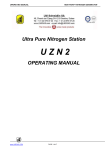
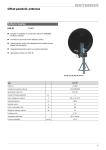

![Wellcolex Colour Shigella [FR]](http://vs1.manualzilla.com/store/data/006466650_1-1a6abb5cf7f4f166799020fc4ffff265-150x150.png)

